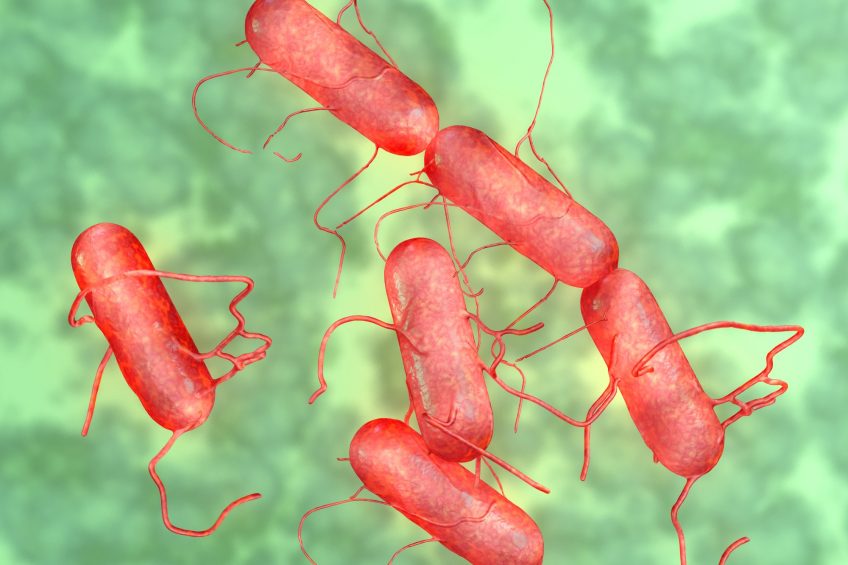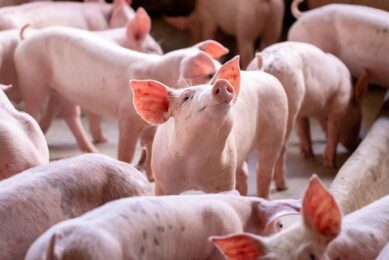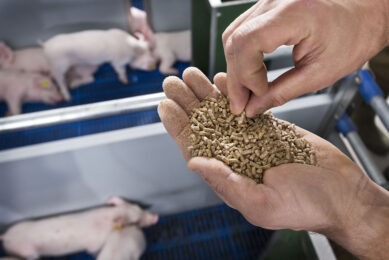Precision butyrate to support Salmonella control in pigs

For more than one reason, Salmonella is a pathogen to watch. It is one of the most common food-borne pathogens and with antimicrobial resistance becoming a problem, also multiresistant strains of Salmonella have been identified. How to tackle Salmonella in 2017?
In the swine industry, Salmonella may be present during the entire production life cycle in pigs and disseminated in faeces for several weeks or months without signs of clinical disease. When Salmonella is present in the gastro intestinal tract (GIT), it might contaminate carcasses during the slaughter process, and become a source of food poisoning and bacterial gastroenteritis in humans.
Ways of transmission for Salmonella
However, Salmonella infection may be transmitted during contact with animals, through contaminated water, or via the environment and may pass through the entire food chain from animal feed, primary production and all the way to households or food-service establishments and institutions.
In pigs and livestock in general, Salmonella will often not instigate disease, unless there are predisposing conditions such as the presence of pathogens or stress factors. Some associated serotypes including Salmonella Typhimurium phage type (PT) 12, and Salmonella Derby are more likely to infect finishing pigs and are considered major causes of food poisoning in humans.
Salmonella 2nd-most reported zoonosis
According to the European Food Safety Authority (EFSA) in 2015, salmonellosis represented the 2nd most reported zoonosis as a major cause of human bacterial gastroenteritis, after campylobacteriosis.
Non-typhoidal Salmonella species are estimated to cause 93.8 million cases of gastroenteritis and 155,000 deaths worldwide each year, about 85% of which are estimated to be foodborne, establishing Salmonella as having a significant public health and economic impact on society. Pork products are among the top food-borne sources of Salmonella globally, which also has a negative impact on the agri-food and trade sectors, due to costly recalls of contaminated products.
Harmful strains to antimicrobial drugs
A particularly worrisome trend concerns the worldwide rapid emergence of resistant harmful strains to antimicrobial drugs. The use of closely related antimicrobials in human and the swine industry has led to an increase and persistence in multidrug-resistant particularly strains of Salmonella, Campylobacter and E. coli.
It has been documented that Salmonella strains can acquire antibiotic resistance in animals, before transmission to humans through the food chain. In pigs, Salmonella strains have been isolated that show increased resistance to kanamycin, streptomycin, sulfamethoxazole, tetracycline and amoxicillin-clavulanic among other important antibiotics such as fluoroquinolones and cephalosporins.
Drastic reduction of antibiotics in livestock production
Since the ban of antibiotic growth promoters AGPs in 2006, the countries within the European Union and many others outside the EU, have taken steps to drastically reduce the use of antibiotics in livestock production. Nutritionists have looked for alternatives to antibiotics in an attempt to reduce Salmonella presence during the different stages of pig production life cycle, and therefore reducing the potential risk of prevalence, shedding and enteric diseases in humans.
Feed additive supplementation provide a promising approach to reduce Salmonella colonisation by different modes of action that create a hostile environment for bacterial colonisation of certain (pathogenic) species and a favourable one for beneficial bacteria. In addition, they might strengthen the entire GIT, stimulate the immune system, and modulate gene activity related to virulence or colonisation pathways in bacteria.
Specific characteristics of butyrate
Butyrate, for instance, is a salt of a short-chain fatty acid that is described to downregulate Specific Pathogenicity Island 1 (SPI1) genes inside Salmonella bacteria. This causes a dramatic attenuation of their capacity to invade intestinal epithelial cells and to colonise the intestinal tract in pigs.
In addition, butyrate has been described as a trigger for the expression of antimicrobial Host Defence Peptides (HDP’s) in the intestinal tract of animals, thereby limiting the growth of several enteric bacterial genera, including Salmonella.
Butyrate supporting swine performance
The Adimix line (Nutriad) consists of butyrate products that support performance and health in swine, by stimulating digestive, immunological and developmental mechanisms in the digestive tract. One product in this line, the product Adimix Precision, has a coating that is capable of delivering butyrate throughout the entire GIT, including the hindgut, where Salmonella resides. This strategy has been shown to reduce Salmonella colonisation in poultry and pigs.
In 2016, a study was published describing a study where the effect of feeding late finishing pigs (about 4 weeks before slaughter) with this approach was evaluated, on Salmonella-challenged commercial pig farms in Ireland.
Detecting Salmonella in faeces
The study showed that at day 28 of the trial, the probability of detecting Salmonella in faeces was strongly reduced in the group that received a diet including this additive (30%), compared to the animals from the control group (66%), see also Figure 1. This resulted in a statistically significant reduction of Salmonella seroprevalence at slaughter (Figure 2).
Of note, apart from the effect on Salmonella, an improvement in average daily feed intake (ADFI), average daily gain (ADG) and feed conversion ratio (FCR) was observed in the pigs having received the diet that included the additive (Figure 3). Remarkably, even with an inclusion level of 3 kg/tonne, this led to a positive return over investment (ROI) and gave a feed cost benefit of €0.04/kg live-weight gain.
Effect in the finisher pig stage
It is important to note that the trial was set up to scientifically evaluate the potential of supplementing a high dosage in the finishing stage only. Other experiments that were conducted in the past, both in institutes and in the field, highlight the extra benefits of administering this product in other stages as well, such as in weaning piglets.
It should be stressed that reduction of Salmonella load from production to slaughter can only be achieved with a comprehensive approach, combining the use of feed additives and the implementation of several hygienic measures and biosecurity protocols. In such a complete Salmonella control programme, the additive will be of benefit to decrease the presence of Salmonella inside the animal’s intestinal tract.
Suppressing enteric growth of Salmonella in pigs
In summary, the results from the study presented here are consistent with earlier findings on the capacity of Adimix Precision to suppress enteric growth of Salmonella in animals and under field conditions. As such, it can contribute to food safety during animal production, aside from its well-documented effect on intestinal health and animal performance.
References are available on request.
Join 18,000+ subscribers
Subscribe to our newsletter to stay updated about all the need-to-know content in the pigsector, three times a week. Beheer
Beheer










 WP Admin
WP Admin  Bewerk bericht
Bewerk bericht